- Home
- Learn Japanese Language FAQ
- How do I use negative imperative in plain form?
How do I use negative imperative in plain form?
by Holly
(United States)

Japanese imperative-form 止まれ (tomare)
The polite imperative-form is te-form + kudasai and the negative is te-form + dekudasai.
But when I want to say "Do that!" or "Don't do that!" I would prefer using the plain form.
I know that the plain Imperative is just the te-form, so "Do it!" would be in romaji written: "Shite!". But how do I form the negative Imperative?
Normally I would just think "Shitenai!" but I found this sentence "Baka ni surun ja nai!"
and was told that it can be translated as "Don't tease me!" or "Don't be an idiot!"
So, how is it formed?
And why can't I find any information about "ja nai" and ja nakatta"?
Reply:
Hi Holly,
I think you've mistaken the Japanese imperative-form with て-form + ください (te-form + kudasai). Japanese imperative-form or command-form, 命令形 (meireikei) in Japanese, is rarely used as it's very rude to used this form during normal conversation. It's used to order or command someone to do something.
But you'll still hear it used in some occasions, for example, when the boss is yelling at his subordinates, or when the angry father is reprimanding his children.
It's also commonly used in anime and manga. Other than that, you don't quite use it frequently, especially to your friends or colleagues, unless you're really angry.
However, I would discourage you to use imperative-form to your friends. (I'll explain how to create imperative-form later)
Whereas て-form + ください (te-form + kudasai) is much more polite when you make request. Even if you use the plain-form, which is formed by omitting the ください (kudasai), it sounds more polite than the imperative-form.
The negative-form is ない-form + でください (nai-form + de kudasai) instead of "te-form + dekudasai" (You've made a mistake in your question). Similarly, the negative plain-form is formed by omitting the ください (kudasai), i.e., ない-form + で (nai-form + de).
You can find out more about て-form + ください (te-form + kudasai) and ない-form + でください (nai-form + de kudasai) in this page.
How to Create Japanese Imperative-form?
For Group 1 Verbs, change the u-sound in the last word to e-sound. For example, よむ (yomu) ends with む (mu). If you change it to e-sound, it becomes め (me). So よむ (yomu) becomes よめ (yome). Similarly, きく (kiku) becomes きけ (kike).
All Group
Group 3 verbs are irregular verbs. Just memorize them by hard. The imperative-form of する (suru) is しろ (shiro), and the imperative-form of くる (kuru) is こい (koi).
One exception when the imperative-form is used in a good way is when you want to cheer someone up to do their best. You've probably heard people cheering their own team during a sport event using がんばれ (ganbare), which is the imperative-form of 頑張る (ganbaru).
If you go to Japan, you'll notice that imperative-form is also being used in some of the Japanese signs. For example, you may see this traffic sign 止まれ (tomare), which is a "STOP!" sign. Another sign 入るな (hairu na), which is a "Do Not Enter!" sign, prohibiting you from entering an restricted area.
I'll probably make a separate intermediate lesson on Japanese imperative-form in future.
Negative-form for Japanese Imperative-form
It's very simple to create negative imperative-form. Append な (na) to the dictionary-form of the verb (all 3 groups).
For example, いく (iku) becomes いくな (ikuna - don't go), いう (iu) becomes いうな (iu na - don't talk), たべる (taberu) becomes たべるな (taberu na - don't eat), する (suru) becomes するな (suru na - don't do), くる (kuru) becomes くるな (kuru na - don't come).
So to answer your question on the negative imperative-form for "Don't do that!", it would be するな (suruna). The imperative-form for "Do that!" would be しろ (shiro).
じゃない (ja nai)
じゃない (ja nai) is the colloquial-form of ではない (dewa nai) and the polite-form is ではありません (dewa arimasen).
じゃなかった (ja nakatta) is the colloquial-form (past tense) of ではなかった (dewa nakatta) and the polite-form is ではありませんでした (dewa arimasen deshita). じゃない (ja nai) is normally used in conversation.
You add じゃない (ja nai) to na-adjective or noun to create the negative-form. For example, 彼は先生じゃない (karea wa sensei janai) means "He is not a teacher".
バカにする (baka ni suru) means "look down on" or "make fun of". バカにするんじゃない (baka ni surun janai) means "don't look down on (me)" or "don't make fun of (me)".
Find out more about ではない (dewa nai) in the this page about Japanese past tense.
Hope this helps,
Kia Leng











